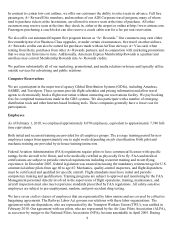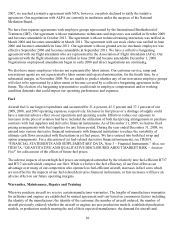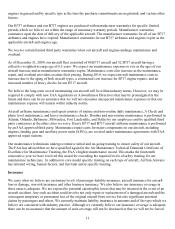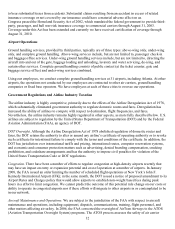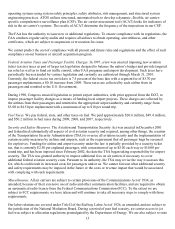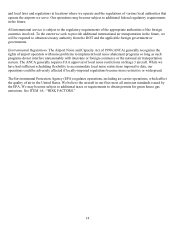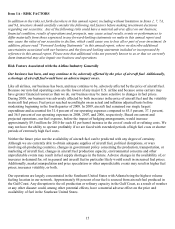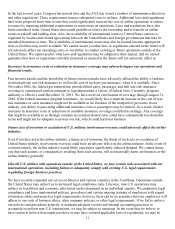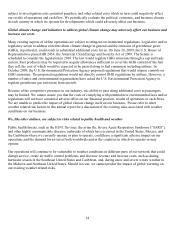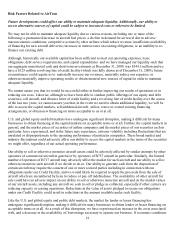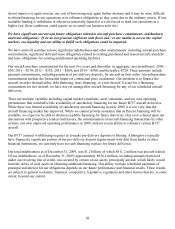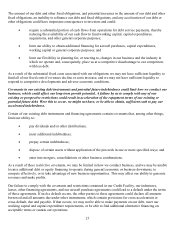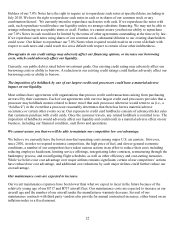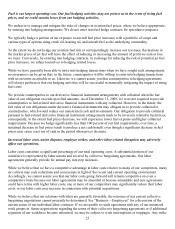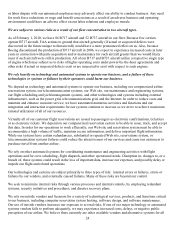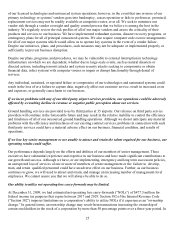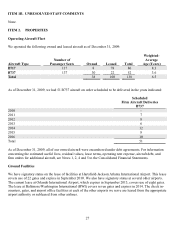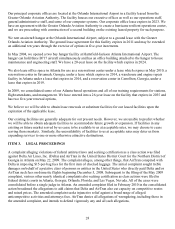Airtran 2009 Annual Report Download - page 28
Download and view the complete annual report
Please find page 28 of the 2009 Airtran annual report below. You can navigate through the pages in the report by either clicking on the pages listed below, or by using the keyword search tool below to find specific information within the annual report.19
Risk Factors Related to AirTran
Future developments could affect our ability to maintain adequate liquidity. Additionally, our ability to
access alternative sources of capital could be subject to increased costs or otherwise be limited.
We may not be able to maintain adequate liquidity due to various reasons, including one or more of the
following: a pronounced increase in aircraft fuel prices, a decline in demand for air travel due to adverse
macroeconomic conditions; competitive actions by other airlines which reduce revenue; insufficient availability
of financing for new aircraft deliveries; increases in interest rates on existing obligations, or an inability to re-
finance our existing debt.
Although, historically our available capital has been sufficient to meet our operating expenses, lease
obligations, debt service requirements, and capital expenditures and we have managed our liquidity such that
our aggregate unrestricted cash and short-term investments at December 31, 2009, was $544.3 million and we
have a $125 million revolving line of credit facility (which was fully drawn as of December 31, 2009), future
circumstances could require us to materially increase our revenues, materially reduce our expenses, or
otherwise materially improve operating results or obtain material new sources of capital in order to maintain
adequate liquidity.
We cannot assure you that we would be successful either in further improving our results of operations or in
reducing our costs. Likewise, although we have been able to conduct public offerings of our equity and debt
securities, sell aircraft, and obtain a letter of credit facility and a revolving line of credit facility over the course
of the last two years, we cannot assure you that, in the event we need to obtain additional liquidity, we will be
able to access the capital markets, sell additional aircraft, utilize, renew or extend existing financing
arrangements, or obtain new financing on terms acceptable to us or at all.
U.S. and global equity and debt markets have undergone significant disruption, making it difficult for many
businesses to obtain financing in the capital markets on acceptable terms or at all. Further, the capital markets in
general, and the market prices of securities of airline companies and the market prices of our securities each in
particular, have experienced, and in the future may experience, extreme volatility including fluctuations that are
unrelated or disproportionate to the operating performance of particular companies. These broad market and
industry fluctuations could adversely affect our ability to access the capital markets or the terms of the securities
we might offer, regardless of our actual operating performance.
Our ability to sell or otherwise monetize aircraft assets could be adversely affected by similar attempts by other
operators of commercial aircraft in general or by operators of B737 aircraft in particular. Similarly, the limited
number of operators of B717 aircraft may adversely affect the market for such aircraft and our ability to sell or
otherwise monetize such aircraft if we decide to do so. Our ability to generate cash from the disposition of
certain aircraft may require the consent of one or more secured parties including in connection with our
obligations under our Credit Facility, and we would likely be required to apply the proceeds from the sale of
aircraft which are encumbered by liens to reduce or pay off indebtedness. The availability of other aircraft for
sale could have an adverse impact on our ability to sell or otherwise monetize aircraft and on the market values
of our aircraft assets, including any aircraft we seek to sell or pledge as collateral, especially if other carriers are
reducing capacity or ceasing operations. Reductions in the value of assets pledged to secure our obligations
under our Credit Facility could result in reductions in the amount available under such facility.
Like the U.S. and global equity and public debt markets, the market for lender or lessor financing has
undergone significant disruption, making it difficult for many businesses to obtain lender or lessor financing on
acceptable terms or at all. As a result of this disruption, we have experienced an increase in the costs associated
with, and a decrease in the availability of, borrowings necessary to operate our business. If economic conditions


